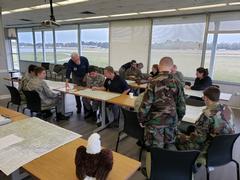Staff Sections
Main Content
Cunningham Field Composite Squadron Hosts Air Operations Training and Familiarization
All five Group 3 squadrons support initiative at Coastal Carolina Regional Airport
12/21/2019–NEW BERN, NC–Cunningham Field Composite Squadron (MAR-NC-160) hosted air operations training and familiarization on 23 November 2019. Six cadets and fifteen senior members of Civil Air Patrol (CAP) from all five Group 3 squadrons supported this initiative, hosted at Coastal Carolina Regional Airport (KEWN). Training objectives were divided into three categories to showcase advanced Emergency Services (ES) training missions and cadet aerospace education initiatives.
Six NC-160 cadets were eager to return to the Eastern North Carolina skies as part of the Aerospace Education Orientation Flight program. Sandhills Senior Squadron (NC-171) aircrew were prepared to support this objective but were unable to fly to New Bern due to poor weather and a low cloud ceiling in the Fayetteville area. The news came as a disappointment but the cadets quickly responded and shifted their focus to indoor training activities. Updated copies of the Charlotte Aviation Sectional with CAP grid were distributed and served as excellent training resources for various exercises. Cadets were tasked with locating targets and landmarks in the CAP grid system and converting them to the appropriate latitude/longitude coordinates. Radio frequencies were identified and discussed for each airport including the Automated Surface Observing System (ASOS) weather report at KEWN. Mission planning and alternative routes began a topic of discussion to emphasize the importance of situational awareness and appropriate Operational Risk Management.
Cadets were also tasked with locating the Emergency Locator Transmitter (ELT) training beacon by conducting a ramp search using a “Little L-Per” Direction Finder (DF) by L-Tronics. Under the direction of 1st Lt Ken King, cadets were shown the principles of operation for this particular device before searching for the target. CAP is assigned several types of DF equipment and it is important to understand the differences and capabilities of different equipment. The highlight of this event was an invitation to climb the KEWN Control Tower and communicate with the Air Traffic Controller (ATC) on duty. Cadets were briefed on incoming and outgoing aircraft and how the ATC manages aircraft under Visual Flight Rules (VFR) or Instrument Flight Rules (IFR).
Capt Gary Shelley (NC-057) presented a brief to multiple pilots to start the day. Capt Shelley, the Group 3 Standards and Evaluation Officer, had planned on flying N98426 from Rocky Mount-Wilson Airport to provide familiarization and new pilot check rides but was forced to drive due to the poor weather conditions. His brief detailed and reviewed the CAP Form 5 checklist, aircraft questionnaire, and CAP Pamphlet 70-12. He then guided three new NC-160 pilots through the common processes and follow-up steps required to become qualified CAP pilots. The afternoon hours enabled 1st Lt Danny Malott to complete his Form 5 requalification check ride prior to his departure home to Elizabeth City Coast Guard Station (KECG). Capt Shelley’s insights were valuable and NC-160 is appreciative of his efforts.
The final objective required support from N741CP, a Cessna 182 based in Elizabeth City. An NC-305 aircrew consisting of 1st Lt Danny Malott, 1st Lt Ed Ish, and 1st Lt Ken King responded to the task. This aircraft supported search and rescue missions and aerial surveillance in areas North-East of New Bern. Capt Brian Mouat conducted a brief familiarization flight using N741CP to maintain passenger currency. Capt Mouat conducted the next sortie with 2d Lt Sean Murphy (Mission Observer) and Maj Kimberly Morton (Mission Scanner) to execute a route search, conduct reconnaissance of airfield infrastructure, communicate with Mission Base at KEWN using CAP radios, and identify geological features at various latitude/longitude coordinates. Weather conditions prevented three additional aircrews from completing Specialty Qualification Training Record requirements, so they focused on classroom tasks and exercises in its place. 1st Lt King also finished his qualification requirements for Flight Line Marshaller.
Special thanks are given to Tradewind Flight Services who graciously opened their flight line classroom facility for this training event. SM Jen Seaman prepared a delicious lunch for all participants, courtesy of NC-160. Capt Robert Rimmer of NC-079 assisted with ES training planning and Orientation Flight Coordination. Maj James Newton of NC-169 assisted with Flight Release Officer responsibilities throughout the morning and afternoon. North Carolina Wing Emergency Services Training Officer, Maj Alberto Griffa, provided innovative training concepts and weeks of planning support to help execute this training event.
The next air operations training event is scheduled for 22 February 2019 at Coastal Carolina Regional Airport in New Bern. It will include a small Incident Command Post featuring an Air Operations Branch, Mission Staff Assistants, Mission Radio Operators, and Mission Safety Officer. Orientation rides will be available to cadets who are interested. Emergency Services exercises will be performed to improve pilot proficiency and train members in Mission Observer, Mission Scanner, and Airborne Photography missions.
Cunningham Field Composite Squadron's Headquarters is located at Marine Corps Air Station Cherry Point and conducts weekly meetings throughout the year.
Sub Content
- My Account
- Member Login
- Register for an account
Search
- Recent Articles
- Cunningham Field Composite Squadron Hosts Air Operations Training and Familiarization
- NC Wing CyberPatriot Preliminary State Award Winners Announced
- Tar River Composite Squadron Cadets Compete in CyberPatriot Competition
- Civil Air Patrol Remembers Veterans for Christmas
